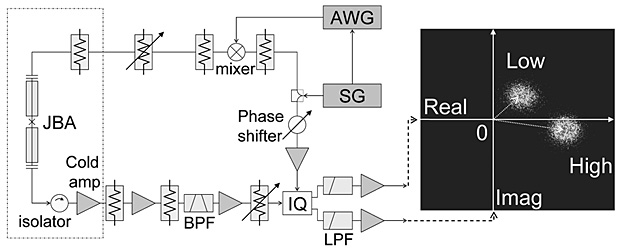Physical Science Laboratory, *Tokyo University of Science
A superconducting flux qubit has potential for use as a device in quantum
computing. To read the qubit state, we usually use a SQUID to detect the
small magnetic field generated by the supercurrent of a superconducting
flux qubit [1]. However, this readout method changes the SQUID state to
the voltage state, so the backaction of the measurement is large and high-speed
measurement is also difficult. This makes it hard to execute the quantum
algorithm, which reads the qubit state several times during the coherence
time. Therefore, we attempt to read flux qubits using a Josephson bifurcation
amplifier (JBA) [2], which employs the bistability of a non-linear resonance
circuit. With this readout method, the Josephson junction superconducting
state is maintained during the measurement thus making it possible to achieve
a fast and ultimately small backaction readout as with a quantum non-demolition
measurement.
We design the flux qubit and SQUID structure at the center of a coplanar waveguide, both sides of which are connected to a capacitor. We then measure the transmission characteristics of this sample. Because of the non-linearity of the Josephson junction, the resonance frequency shifts to the lower frequency side with increases in applied microwave power, and the resonance spectrum shows a jump above the critical microwave power. This is a transition from one stable state to another and means that the bistable state of the non-linear resonator has appeared. The stable resonance state that appears depends on the resonator state. So, by realizing magnetic coupling between a nonlinear resonator and a qubit, we can reflect the flux qubit state to the resonator and read the qubit state. We can measure the qubit state by the homodyne detection of a transmission microwave because the amplitude and phase of the transmission microwaves of each stable resonance state are different. Then we attempt to read the qubit state by employing pulsed microwaves. Figure 1 shows a block diagram of a pulse measurement system and an example readout. A pulse-modulated microwave passes through the JBA circuit and is amplified. The signal interferes with the reference microwave, and then we can obtain 0-degree and 90-degree phase components. From this amplitude and phase information, we can clearly separate two states and successfully read the flux qubit state [3].
This work was supported by KAKENHI(18201018,18001002).
[1] Caspar H. van der Wal et al., Science 290 (2000) 773.
[2] I. Siddiqi et al., Phys. Rev. Lett. 93 (2004) 207002.
[3] K. Semba, K. Kakuyanagi et al., Quantum Information Processing 8 (2009) 199.
 |
||
|